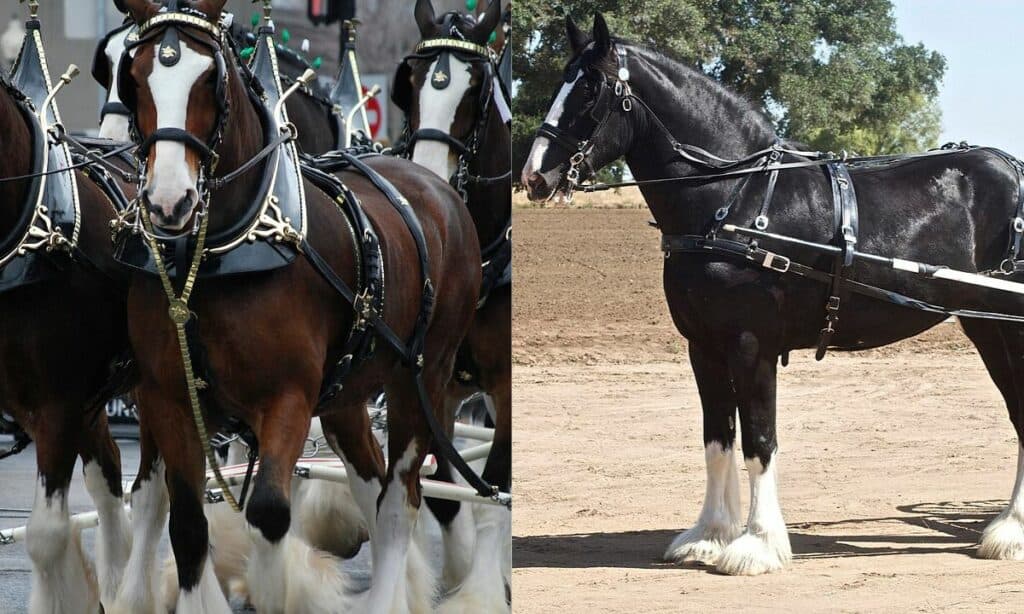- Best Antibiotics for Horse Wounds: What to Expect When Your Horse Has an Injury - September 20, 2023
- Bronco vs Mustang Horse: Are They the Same? - September 8, 2023
- Thoroughbred vs Quarter Horse - September 8, 2023
Are you planning to add a new draft horse to your stable? Then there’s a good chance you’re deciding between these two: Shire Horse vs. Clydesdale.
I perfectly understand how difficult this decision can be since these two popular breeds have a lot in common, and they’ve even been cross-bred in the past. Can’t tell the one from the other? Don’t worry; I’ve mistaken them a few times, too!
But although you can’t go wrong with either of these versatile and obedient types of horse breed, each has its specifics that can make a difference in certain situations.
I’ve had a few experiences with a spirited Clydesdale in the past for example. They’re absolutely adorable and very loving, but definitely not as easy to deal with for absolute beginners.
This detailed side-by-side comparison should answer all your questions and help you make the right decision.
Bottom Line Up Front:
A Shire Horse is an old English breed beloved for its obedient nature, robust and natural appearance, and universal usefulness. A Clydesdale is a younger, slightly smaller breed that suits more experienced equestrians better. It can also be more expensive.
Main Differences Between Shire Horse vs Clydesdale
The main differences between Shire Horse vs Clydesdale are:
- Shire Horse is an old English horse breed, whereas Clydesdale is a younger Scottish breed.
- Shire Horse is generally taller, thicker, and more robust, whereas Clydesdale is slightly smaller, thinner, and more defined.
- Shire Horse is an excellent choice for a beginner thanks to its obedient temper, whereas Clydesdale, although also calm, can be more energetic and spirited.
- Shire Horse is usually relatively affordable, whereas Clydesdale costs more.
Key Characteristics: Shire Horse vs. Clydesdale
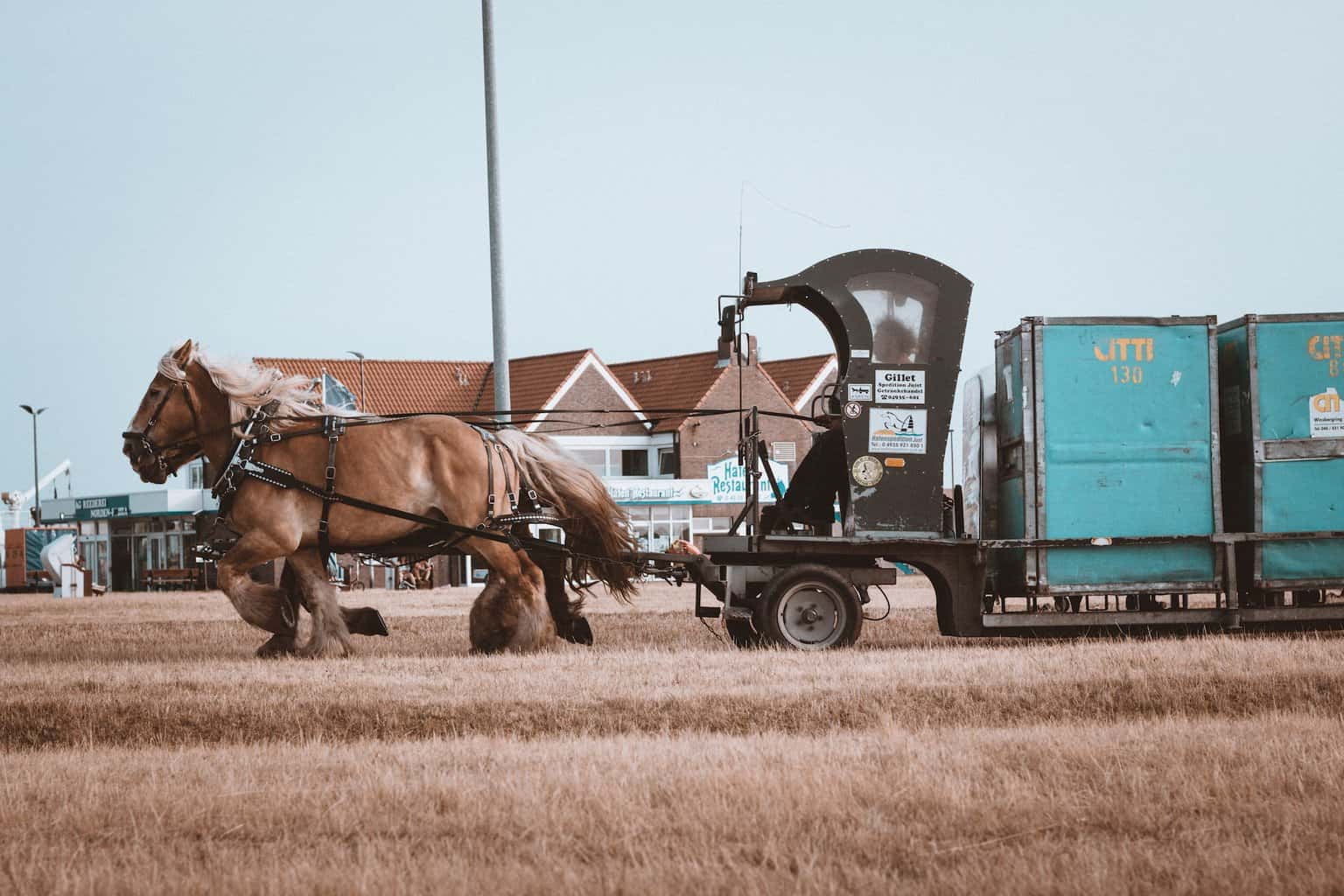
Shire Horse and Clydesdale have much in common, but let’s focus on the attributes that set them apart.
Whether you’re looking for a specific appearance, ability, or genetic trait, the following analyses of their significant characteristics will help you pick the one that’s right for you.
Shire Horse vs Clydesdale Characteristics Summary
| Characteristics | Shire Horse | Clydesdale |
| Aesthetics | Usually solid color (black, brown, grey, etc.). Rounded face, large eyes. Naturally long tail. | Solid colors (black, brown, roan, bay), often with white markings. Flat face with wide eyes. Docked tails. |
| Body build | Tall and robust horse (up to 5 ft 8 in height and weighing up to 2,500 pounds) | Still tall (up to 5 ft 6), but slightly smaller and more slender in comparison with Shires (weigh up to 2,300 pounds). |
| Genetics | Relatively common polysaccharide storage myopathy, joint problems, slightly shorter average life expectancy. | Quite prone to chronic progressive lymphedema and skin problems in the leg area. Lifespan ranges from 20 to 25 years. |
| Temperament | Calm, obedient, loyal. Ideal for inexperienced riders. | Calm, easy to train, but slightly more playful and energetic. |
| Common use | Suitable for work but also as a companion and for leisure riding. | All sorts of work-related uses, but also shows, parades, and riding. |
| Price and requirements | Relatively affordable but demanding when it comes to feeding due to its size. | More expensive yet potentially slightly less demanding regarding care and feeding. |
| Origins | England, 11th century. One of the oldest British horse breeds. | Half of the 19th century, Scotland. |
Aesthetics
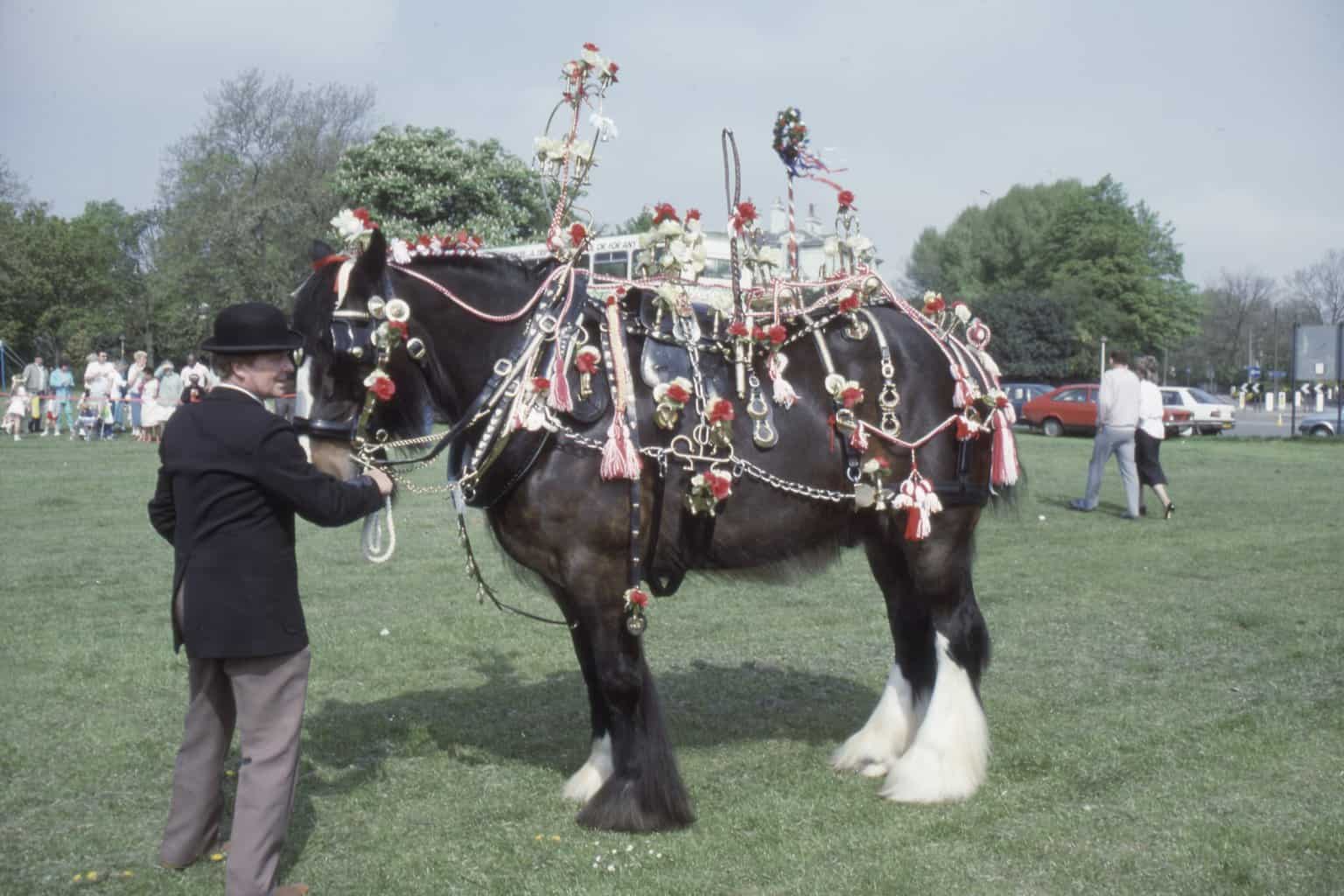
All horses are beautiful, but we all have unique tastes and preferences. When it comes to Shire Horse, it can easily enchant you with its large eyes and muzzles on a well-rounded face. I’ve fallen in love with many Shire horses in my time. They truly are beautiful creatures.
Clydesdale, on the other hand, has a visibly flatter face. Its eyes are wider. It often sports prominent white marks on its face or other body parts.
Talking about the coat color, both breeds can be black or brown. In my experience, these are their most usual colors.
For Shire Horses, however, shades of grey and lighter chestnut color are also quite typical, whereas Clydesdale horses can commonly be seen in roan and bay colors. (See our horse colors guide for more information on equine colors in general).
If you prefer horses with a natural appearance, you’ll surely appreciate that Shires are typically left with naturally long tails, whereas Clydesdale equines usually have their tails docked. Both breeds have lovely ‘feathers’ on their legs.
Body Build
Body build makes these two horse breeds probably the most distinguishable, even for an untrained eye. Still, even I sometimes need to see the two side by side to be entirely sure.
Shire Horses are characterized by robust and tall bodies with an overall appearance of dominance. These giants are really easy to spot among the other breeds if you focus on their height (up to 5 ft 8). They can also be pretty heavy (up to 2,500 pounds).
That being said, Clydesdale is not a tiny horse, either. These equines are usually only a few inches shorter than Shires, but they can be visibly less robust (not weighing more than 2,200 – 2,300 pounds, but often even below 2,000 pounds).
Some of my friends prefer Clydesdales due to the more defined muscles and overall athletic image. Their necks are slightly curved; their legs are short yet nicely formed.
However, many people are, on the contrary, more attracted to the impressive thickness of the Shire Horse. These horses simply look raw, natural, and incredibly strong.
Genetics
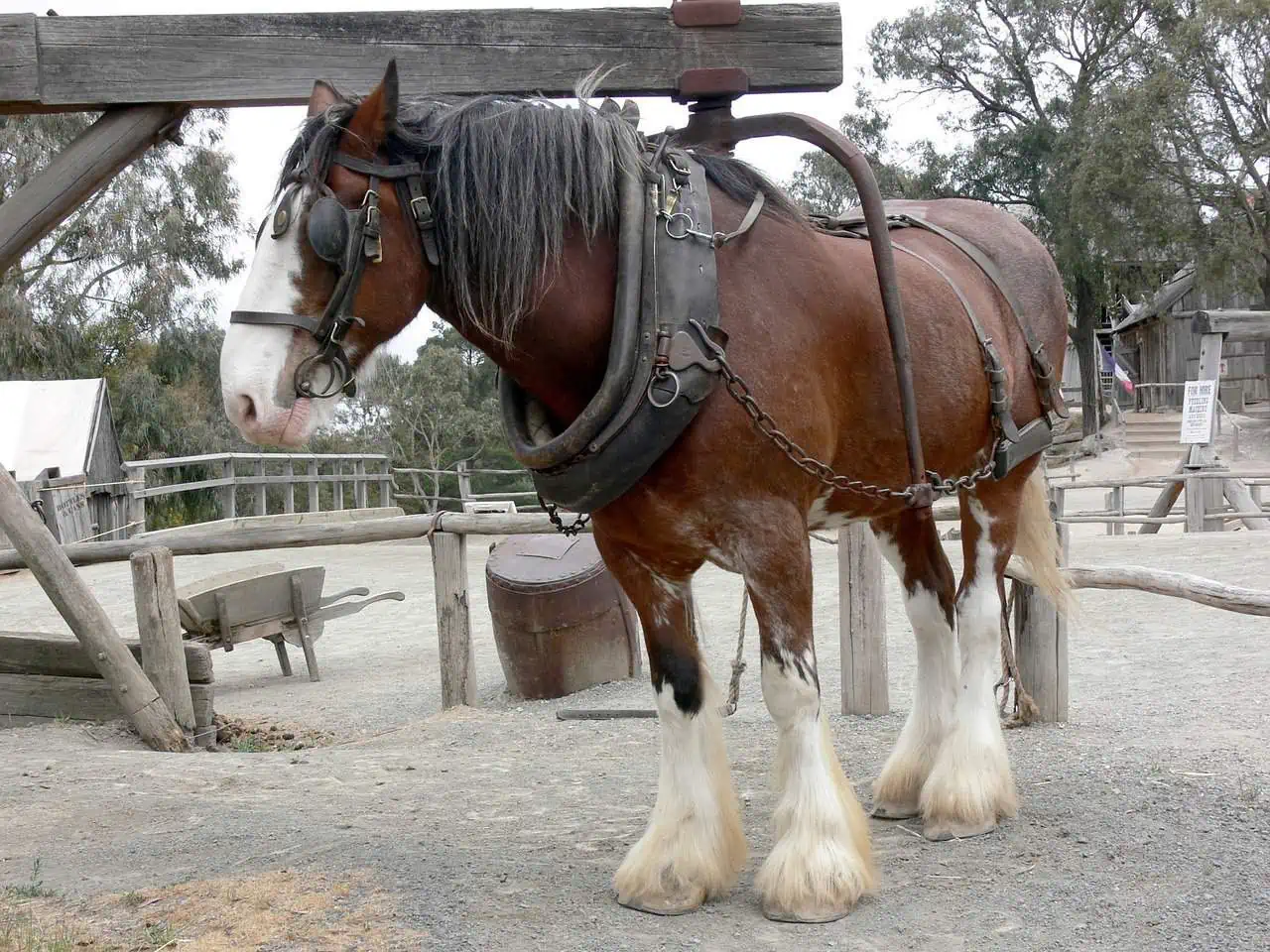
Draft horses are generally quite resilient and healthy, but they are prone to certain diseases (often genetically conditioned) you should certainly know about.
Shire Horse, for example, is susceptible to polysaccharide storage myopathy, a genetic disorder demonstrated in muscle soreness, tremors, weakness, and overall low performance.
Due to their size, they are also more prone to joint issues, and their lifespan is, on average, slightly shorter than in some other breeds (around 20 years).
Clydesdales are also considered generally healthy animals with few potential genetic issues. If these animals suffer from health issues, these are typically related to their legs.
Most commonly, Clydesdales develop chronic progressive lymphedema, demonstrated mainly by leg swelling. Some animals can also suffer from various skin conditions related to the thick and long hair on their legs.
This horse’s lifespan is between 20 and 25 years with this breed.
Temperament
Most draft horse breeds are known for their calmness, obedience, excellent work ethic, and ability to adapt to almost any situation. After all, this is what these animals were bred for. However, they are certainly not all the same.
In my experience, Shires are perfectly peaceful animals with a thoughtful, mild-tempered nature, and I wouldn’t hesitate to recommend them to any beginner.
People are sometimes intimidated by their giant size, but these horses are really very patient, gentle, and adaptable to all the different types of training.
Clydesdale horses are typically also very calm, friendly, quiet, and well-mannered. Nevertheless, they are known to be slightly more energetic, spirited, and playful, which means they may not be the best horse breed for beginners.
Still, rest assured that these equines are never aggressive or hard to manage. They are used to living in herds, which means they have a perfect predisposition for social and adaptable characters.
Common Use
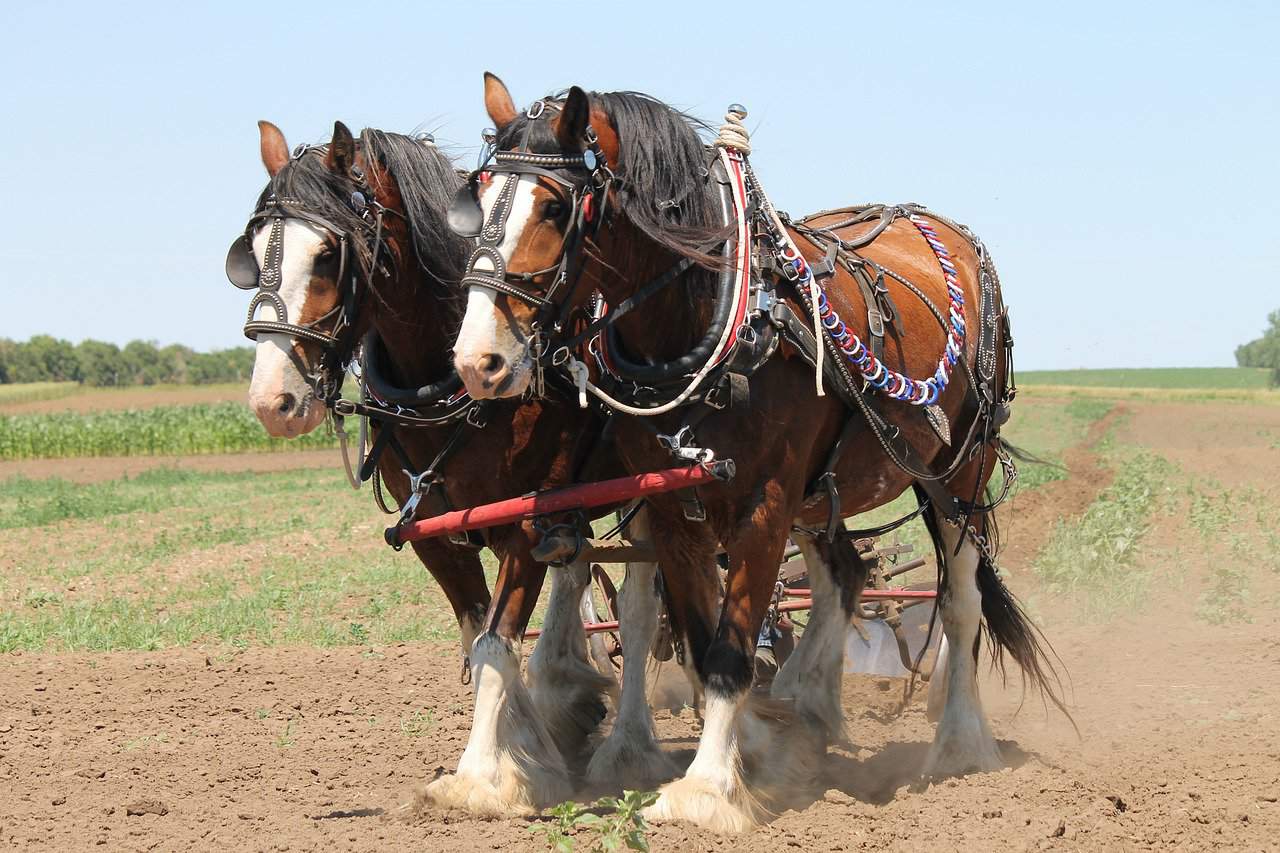
Draft horses were, in general, bred to serve as hard workers. However, there are not many opportunities for this type of use anymore. Having them simply as companions or even racers in some disciplines becomes increasingly common.
Shire horses are most commonly used for:
- Leisure riding
- Heavy load pulling
- Transportation
- Heavy racing
- Driving in carts, carriages, etc.
Clydesdale horses have very similar skills, so they are, unsurprisingly, used for all of the above-mentioned. Besides that, they can also often be seen in:
- Parades
- Shows
- Logging
- Tourism
- Agriculture.
To wrap it all up, there’s hardly any activity Shire Horse could do, and Clydesdale don’t (or the other way around), so until you know what to expect from a draft horse, you won’t be disappointed with the abilities of either of these two breeds.
Price and Requirements
If your decision on either of the two compared breeds depends, at least partially, on how much does a horse costs, I’d say you should probably focus on Shire Horse.
Although horse prices can differ significantly based on the animal’s specific origin, bloodlines, age, training, and physical condition, the prices start at approximately $2,000 here, which is relatively budget-friendly compared to other breeds.
Clydesdale is usually more expensive, starting at around $4,000. Of course, you may come across slightly more affordable animals (depending mainly on your location), but it’s more likely that you’ll hear even higher quotes.
Of course, if your budget does not limit you, and you’re after the best of the best, your new Shire or Clydesdale can cost you even up to $60,000.
Besides that, you should also consider the overall requirements for grooming and care. Both breeds are large and, hence, need loads of food and good-quality nutrition.
Shire horse is, based on its size, potentially even slightly more demanding. (Find out how much does a horse eat in a day, in general).
Origins
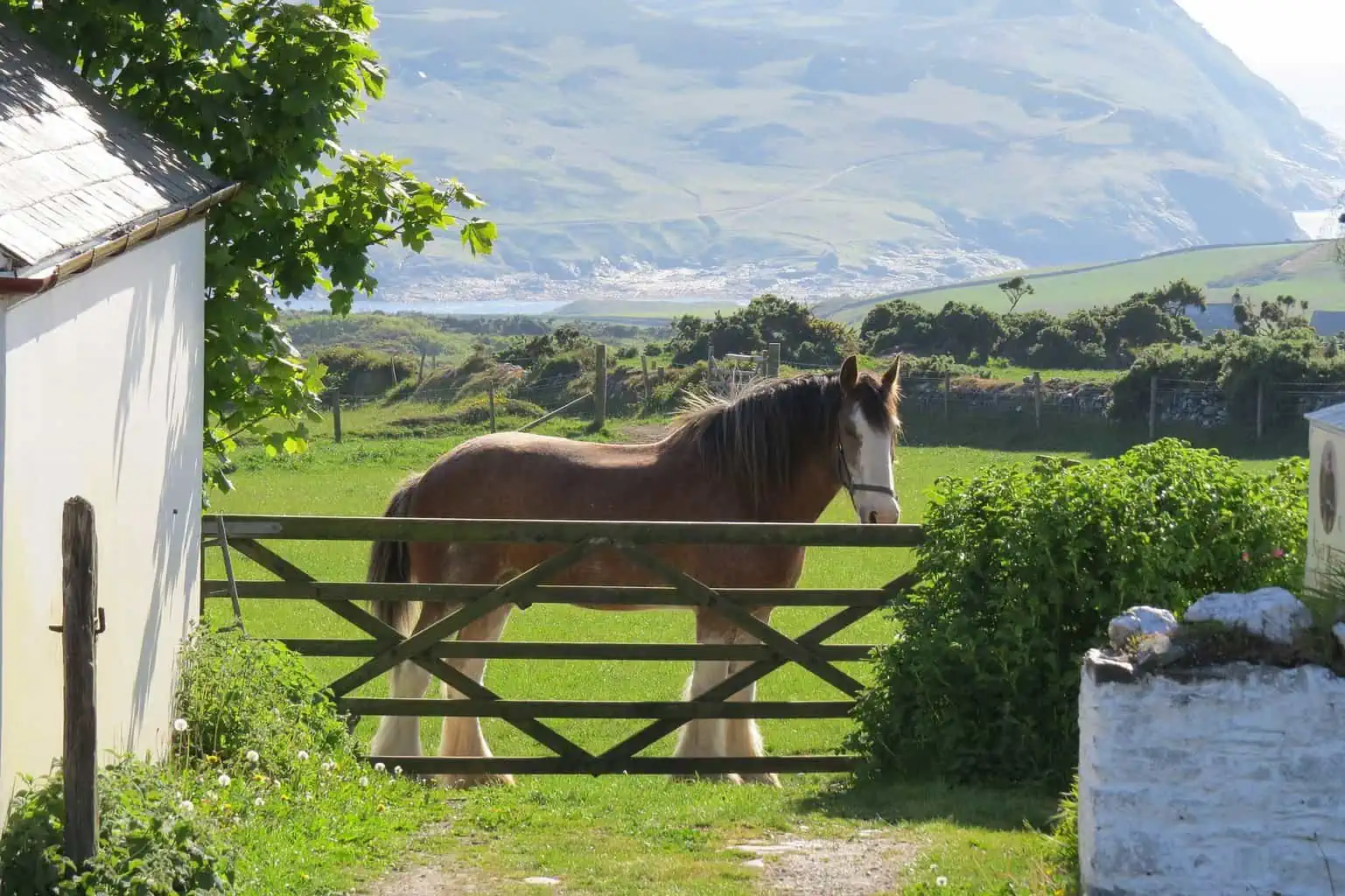
When it comes to history and origins, the two breeds have many similarities as well. They even both come from Great Britain, but whereas Shire Horses originate in England, Clydesdale’s roots can be traced to Scotland.
Shire Horses are much older than Clydesdales, first being bred, based on historical sources, back in the 11th century. As their body build and mild temper suggest, their main original purpose was helping the farmers with heavy physical work.
Thanks to their huge popularity, Shire horses were later exported all across the Commonwealth, including New Zealand and Australia, the US, and Canada.
But eventually, their popularity started dropping in the second half of the 20th century. After all, hard labor was ultimately delegated to modern machinery, so the equines on farms were not irreplaceable anymore.
Soon, the Shires started to be massively crossbred, which helped them maintain relatively strong numbers, despite their diminishing practical usefulness, but this also led to changes in some of their distinctive traits.
One of the breeds Shire Horses were commonly crossbred with was Clydesdale, which is why these two types of horse breeds are so similar nowadays and easy to confuse.
Clydesdale was first officially bred in the 19th century by combining the native horses of Scotland’s Lanarkshire area with Flemish stallion horses. Unsurprisingly, it was also intended for manual labor, mainly in agriculture.
At the peak, Scotland was home to around 140,000 farm horses, most of which shared a Clydesdale blood lineage. Just like Shires, Clydesdales were also heavily exported around the world. They were also deployed in World War I as war horses.
Rider Compatibility
Shire horses are very beginner-friendly. They’re friendly, and very docile. Not a lot can spook a Shire horse. They’ll give new riders a smooth ride, and if you live in a busy area and you need to ride near a road, they should stay nice and calm.
They’re also hard workers. You can put a Shire horse through its paces, making it a good choice if you plan to ride often.
In my experience, Clydesdale horses can be great for beginners, but they tend to have slightly ‘livelier’ personalities, and they can be slightly more unpredictable. They’re kind and gentle, but perhaps a little less predictable. They need a lot of love and attention, but that’s not a bad thing as far as I’m concerned!
If you want a loyal and fun breed, Clydesdales are the way to go. They’re also a beloved breed for showing, as they’re so striking to look at.
Shire Horse and Clydesdale Care
Shire horses and Clydesdales are fun to care for; they’re both calm and patient, and they enjoy a little fuss and attention!
Caring for a Shire or Clydesdale is very similar to caring for any other type of horse, but with a few extra steps in terms of grooming and health concerns. To be honest, I haven’t found much difference between the two breeds in terms of care. They’re pretty closely related in terms of their needs.
Firstly, Shire and Clydesdale horses have iconic feathering on their legs, which look beautiful, but do require more care than other horse breeds. You need to keep these clean and brushed; if not, they can get clogged with dirt, irritate your horse’s skin, and even cause infection.
When you wash your horse, it’s important to allow these delicate, feathery areas to dry completely. If left wet, bacteria can get in, which again can cause infection.
I’ve cared for a Shire horse for a friend in the past. The grooming process is simple, but slightly more time-consuming; on top of everything else I had to do. The feathering is beautiful though, and it is satisfying once it’s done. But you’ll need to factor in the extra grooming time for both breeds.
Both breeds can be prone to chronic progressive lymphedema, a disease affecting the legs. It’s important to keep an eye out for signs (stiffness and cramps) and call a vet to help manage this.
FAQs
Answer: The biggest horse on record was a Shire Horse named Sampson, also known as Mammoth, from Toddington Mills, Bedfordshire, UK. Its height was 7 feet 2 1/2 inches and weighed 3,359 pounds.
Answer: Both breeds are considered strong, but Shire Horse is, on average, stronger. In fact, the strongest horse on record was Shire Horse which pulled 58,000 pounds in 1924.
Answer: Yes. Despite their intimidating size and body mass, both Shire Horses and Clydesdale horses are very gentle, calm, and easy to train.
Other Similar Horses
Still not decided between Shire Horse and Clydesdale? Check out some other options in our guides to a few similar horse breeds below:

